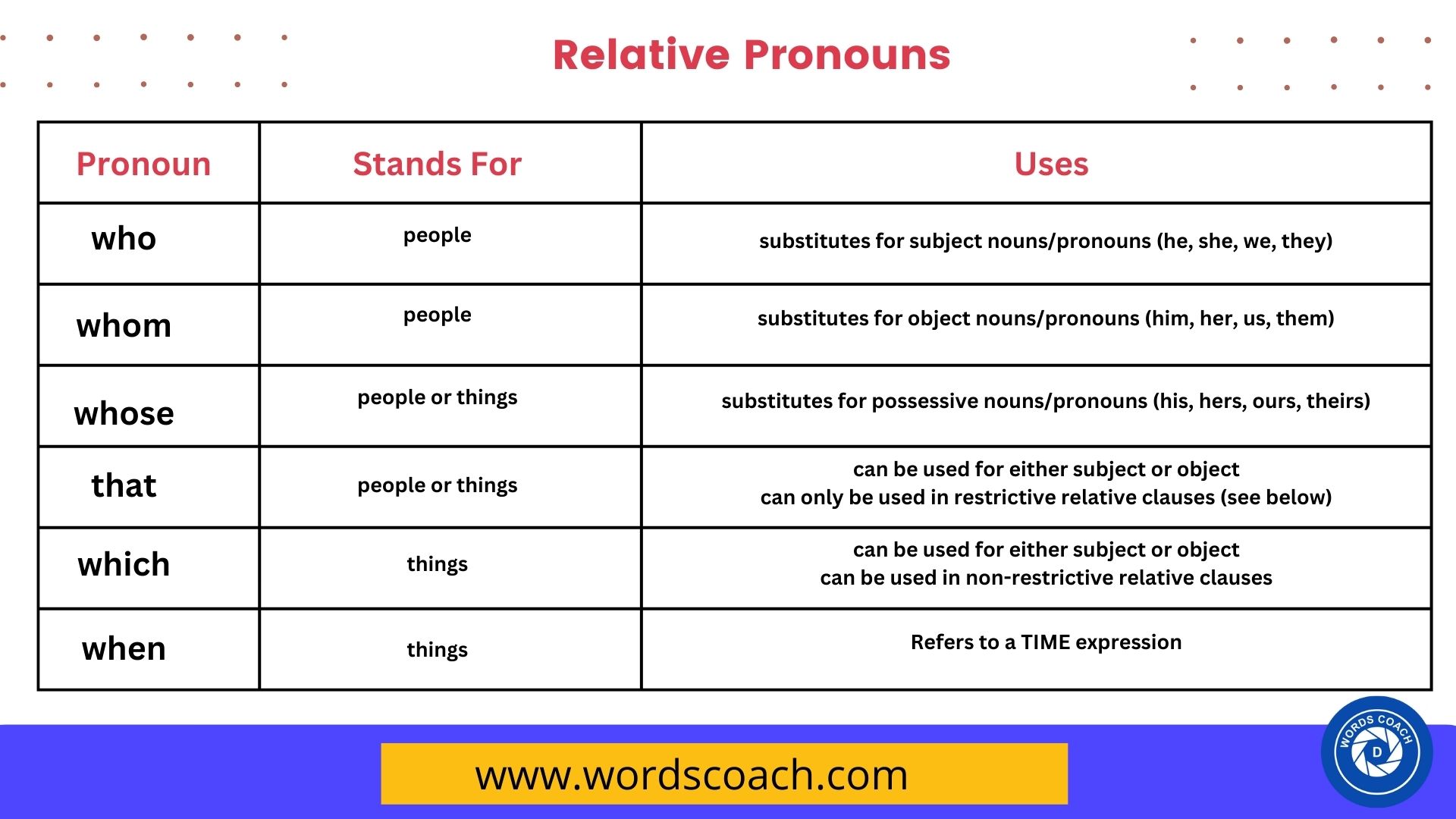Have you ever wondered why certain commas seem essential to understanding a sentence, while others feel like mere punctuation marks? The answer lies in the fine art of restrictive and non-restrictive clauses, a concept that can seem daunting at first but is surprisingly crucial for crafting clear and precise prose.

Image: www.wordscoach.com
A restrictive clause, also known as an essential clause, is like a vital ingredient in a recipe – it’s necessary for the sentence to make sense. It defines a noun, often a person, place, or thing, and without it, the sentence becomes ambiguous or nonsensical. We use restrictive clauses to distinguish one thing from another, offering clarity and specificity. Understanding restrictive clauses is not just a grammar lesson; it’s a key to unlocking the power of communication, allowing us to express our thoughts with precision and impact.
The Essence of Restrictive Clauses: Defining and Distinguishing
What Defines a Restrictive Clause?
A restrictive clause is a dependent clause that provides essential information about the noun it modifies. It directly limits what the noun refers to, making it indispensable for understanding the sentence’s meaning. Think of it as the detective who identifies the real suspect among many possibilities. Here’s the catch: these clauses are never separated by commas!
Identifying Essential Information
The easiest way to spot a restrictive clause is to ask yourself: “If I remove this clause, does the meaning of the sentence become unclear or ambiguous?” If the answer is yes, you’ve found a restrictive clause. Let’s look at an example:
“The people who live in the old house are friendly.”
If we remove “who live in the old house,” the sentence becomes “The people are friendly”. This leaves us wondering: which people? Removing the restrictive clause leaves the sentence vague.

Image: www.studyenglishpage.com
Restrictive Clauses: The Key to Clear Communication
Restrictive clauses are essential for clear communication. They provide a crucial element of context and definition, allowing readers to grasp the precise meaning of the sentence. Without them, our communication could become messy, filled with ambiguity and misunderstandings.
Examples in Action
Let’s explore some real-world examples to see how restrictive clauses make all the difference:
- “The students who failed the exam will have to retake it.” This restrictive clause specifies which students are affected, creating a clear distinction.
- “The car that was in the accident is now in the repair shop.” This restrictive clause identifies the specific car involved, preventing confusion.
- “The books on the shelf are all novels.” Here, the restrictive clause defines the location of the books, narrowing down the potential objects.
The Difference Between Restrictive and Non-restrictive Clauses
While restrictive clauses are vital for clarity, non-restrictive clauses add extra information without changing the core meaning of the sentence. These clauses are set off by commas and act like optional details, providing added context. Let’s consider an example:
“The book, which was published in 1998, is a classic.”
Even without “which was published in 1998,” the sentence is clear. This clause merely adds a bit of information about the book’s publication date. It’s like a fun fact, not a crucial determinant of the book’s identity.
Understanding the Difference: A Practical Guide
Here’s a simple trick to distinguish restrictive clauses from non-restrictive ones: imagine reading the sentence out loud. If you pause after the clause and it feels natural, you’re probably dealing with a non-restrictive clause. If you read smoothly through the sentence, it’s likely a restrictive clause.
Putting the Theory into Practice
Let’s test your understanding with a fun little exercise. Identify whether the highlighted clause is restrictive or non-restrictive:
- “The man who was wearing the brown hat was the one who stole the wallet.” (Restrictive)
- “The book, which I read last week, was incredibly engaging.” (Non-restrictive)
- “The dog that chased the cat is now hiding under the bed.” (Restrictive)
- “The city of Paris, which is known for its romantic charm, is a popular tourist destination.” (Non-restrictive)
Did you get them right? Remember, if the clause is essential for understanding the sentence, it’s restrictive. If it’s just additional information, it’s non-restrictive.
Restrictive Clauses in Academic Writing
In academic writing, restrictive clauses are crucial for conveying precise and clear arguments. They ensure that your writing is unambiguous, leaving no room for misinterpretation.
Using Restrictive Clauses in Research Papers
Imagine writing a research paper on the impact of social media on mental health. Your arguments would be much more effective if you used restrictive clauses to pinpoint the specific aspects you are focusing on. For example, you could write:
“Studies that have investigated the relationship between social media use and anxiety have revealed compelling findings.”
This restrictive clause clarifies which studies are relevant to your argument, making your research more focused and impactful.
Mastering the Art of Restrictive Clauses: A Valuable Skill
Learning about restrictive clauses is more than just memorizing grammatical rules. It’s about understanding a fundamental principle of clear communication. By mastering the use of restrictive clauses, you can refine your writing, make your arguments clearer, and avoid potential misunderstandings. It’s a skill that will serve you well in your academic pursuits, professional life, and everyday interactions.
Which Sentence Contains A Restrictive Clause
Conclusion: Restrictive Clauses for Effective Communication
Restrictive clauses are the unsung heroes of sentence structure, playing a vital role in crafting clear and precise prose. They are the building blocks of clarity, ensuring that our audience understands exactly what we mean. By understanding and utilizing restrictive clauses effectively, we can be confident that our writing will be understood and appreciated. So, the next time you’re writing, take a moment to consider those essential clauses – they are the keys to unlocking a world of meaningful and impactful communication!

:max_bytes(150000):strip_icc()/OrangeGloEverydayHardwoodFloorCleaner22oz-5a95a4dd04d1cf0037cbd59c.jpeg?w=740&resize=740,414&ssl=1)




